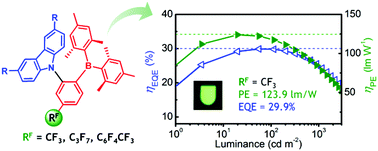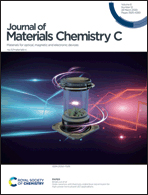Triarylboron-based TADF emitters with perfluoro substituents: high-efficiency OLEDs with a power efficiency over 100 lm W−1†
Abstract
We report boron-based thermally activated delayed fluorescence (TADF) emitters that can lead to high-efficiency organic light-emitting diodes (OLEDs) with high power efficiency and low driving voltage. ortho-Carbazole-appended triarylboron compounds (2–7), in which perfluoroalkyl (CF3 and C3F7) or perfluoroaryl (4-CF3C6F4) groups are attached as secondary acceptors, are prepared and characterized. The compounds exhibit a light greenish to yellow emission in toluene with high photoluminescence quantum yields up to 100%. The twisted donor (D)–acceptor (A) structure, as evidenced by both the X-ray crystal structures and theoretically optimized structures, leads to a small energy splitting (ΔEST < 0.1 eV) between the excited singlet and triplet states, giving rise to strong TADF. High-efficiency TADF-OLEDs are realized with the CF3- and 4-CF3C6F4-substituted compounds as emitters. The optimized OLEDs based on the CF3-substituted emitter (5) show a high external quantum efficiency of 29.9% with a low turn-on voltage of 2.35 V. In particular, the devices achieve an ultrahigh power efficiency (PE) of 123.9 lm W−1 without any light-outcoupling enhancement, which is among the best PE values for the reported TADF-OLEDs. The devices also maintain a high PE at the practical brightness, such as 100 cd m−2 (118.7 lm W−1) and 1000 cd m−2 (82.3 lm W−1).



 Please wait while we load your content...
Please wait while we load your content...